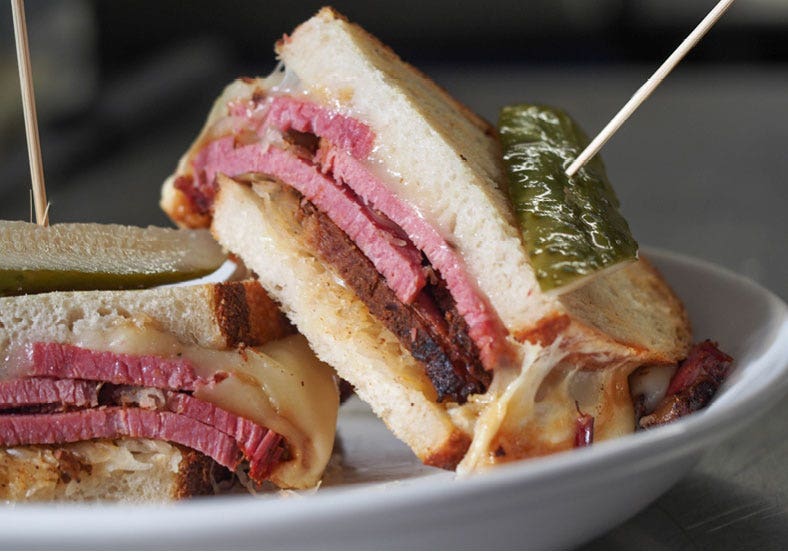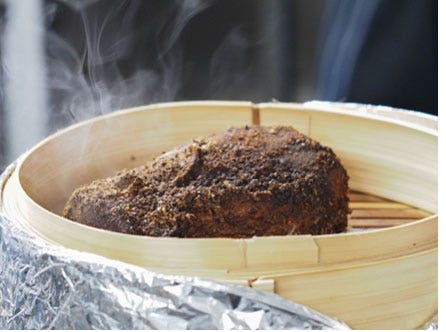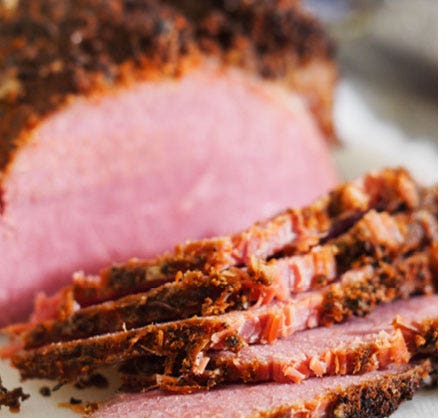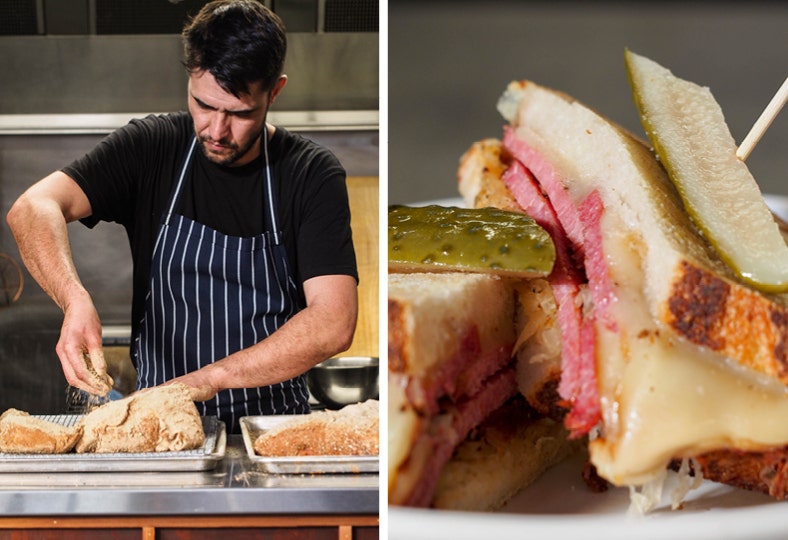It looks like Meg Ryan was having a boring turkey sandwich in the scene in When Harry Met Sally where she fakes an orgasm, famously causing a neighbouring diner to tell the waiter, “I’ll have what she’s having.”
This is an embarrassing goof because the scene is set in Katz’s Deli in New York, and everyone knows that the sandwich most likely to induce orgasms there is the pastrami sandwich, for which Katz’s Deli is legendary.
A centuries-old process developed to preserve meat without refrigeration, pastrami came to New York with Romanian migrants in the late 19th century and is now indelibly associated with the city’s diners, bodegas and booth-lined delis.
Anthony Bourdain, who travels the world making food television, is often asked which dish he craves the most, and he usually says a pastrami sandwich from Katz’s. The scent of it is enough to make him feel “proud to be a New Yorker”.
Usually made from a cheap, stringy cut of beef that’s been brined, air-dried, rubbed with a peppery seasoning, smoked and then steamed until tender, proper pastrami is then sliced and stacked high in a sandwich of rye bread.
You can add Swiss cheese, mustard, or sauerkraut. (A Reuben sandwich is similar, but it’s made with corned beef, not pastrami, and the bread is toasted.) You can have coleslaw or potato salad on the side, and celery soda is a classic accompaniment, although coca cola also hits the spot.
If, by now, you are thinking that you might like to try one of these pastrami sandwiches, you’re in luck. Laffare Melrose in Auckland will add it to their menu next week.
Head chef Luke Adams says he liked the idea of reviving an old classic, and doing it as faithfully as possible. “And I like using cheaper cuts of meat that have been forgotten about, and spending time to make them a lot better. Anyone can cook an eye fillet.”

Adams researched his recipe, and consulted a brother in LA who eats five pastrami sandwiches a week and claims that 25% of his body muscle has been replaced with pastrami.
“There’s a bit of a pastrami revival going on in LA at the moment,” Adams says. “A number of pastrami houses there use a softer bread, like a filled-roll roll, and a sweeter pickle, whereas the New York style is rye bread, which is denser, with the soft meat, a sharp mustard and a tart pickle. Mine’s probably somewhere in the middle.”
Keen to try making hot pastrami at home? It’s a long, laborious process, but it’s worth it.
First, brine your beef. (Or not.)
Traditionally, hot pastrami is made with brisket or navel, which is brined for weeks. “For us mere mortals who don’t have that kind of time, you can just buy a vacuum-packed piece of corned beef from the supermarket,” Adams says. “Take it out, wash all the brine and pink slime off, then soak the meat in water for 24 hours to desalinate it. There needs to be twice as much water to meat, so fill a big pot up to the top and leave it overnight in the fridge.”
Dry it.
Next, dry it with a tea towel or cloth. “Paper towels won’t do the trick. It’s a really hard piece of meat so it has to be manhandled.”
Rub it.
Once it’s dry, rub it liberally with dry spices. For 2kg of meat, which would make 5 or 6 sandwiches, Adams combines 4 tbsp freshly ground black pepper, 2 tbsp ground coriander, 1tsp mustard powder, 1 tbsp brown sugar, 2 tbsp paprika, 2 tsp garlic powder, 2 tsp onion powder and 2 tbsp ground cumin.
“This is based on Katz’s Deli’s rub, but their recipe is all about the hot pepper flavour, whereas I add paprika and cumin to give it a bit more depth.”
This is another step where manhandling is appropriate. “You’ve really got to forcefully push the rub in. Each square inch should get about 2 tbsp of rub. Cake it on there.”

Air-dry it.
Put the meat on a rack so that it’s suspended in mid-air with as little surface area as possible touching anything else, and put the rack in the fridge, unwrapped, for 24 hours. “You’re basically marinating it, so the longer you air-dry it the better. I air-dry mine in its own fridge for three days, but I’ve also done it overnight before, and it came out mean. If you don’t dry it properly, the crust goes soggy and falls off.”
Smoke it.
Smoke the meat with an indirect heat, which is tricky and might trigger your smoke alarms.
“The best option would be to smoke it over charcoal, which you could do if you had a charcoal BBQ with a lid. I use caterer’s gastronorm trays but you could build a smoker in an old roasting dish, although it might smoke out your house,” Adams says.
If you’re doing it inside, put manuka wood chips in the bottom of one corner of a roasting dish, find a steel rack that fits inside and put the meat on top, in the opposite corner. Cover the meat with baking paper to protect it from the tin foil, and then cover the tray with a big tall dome of tin foil, to keep the smoke in.
Set the corner with the wood chips over a low heat, with the meat sitting off the heat, for about an hour and a half. The tray will fill with smoke, so no peeking.
If you’ve got a probe thermometer, the internal temperature of the meat should reach 70-75 degrees to kill any bacteria.
Then pull it out, wrap it in tin foil and refrigerate it overnight, to set the smoky flavours. “If you skip this step, I’ve noticed the pastrami won’t be as smoky,” Adams says.

Steam it.
Put your pastrami into a bamboo or metal steamer, and steam for 1.5-2 hours, making sure that the water doesn’t run out.

Slice it.
You’re ready to eat! Slice your pastrami finely, 2-3mm thick if possible, and fold the slices on themselves, so there’s alternating crust and meat throughout.
“I’ve been using a sourdough, because softer bread can’t handle all the meat juices and when you load it up, it disintegrates, whereas a sourdough is tough enough to handle the jandal,” Adams says.
“Ideally, you’d use a good American mustard, but a lot of the American mustards we get here are not great, so I use a Dijon mustard, homemade mayonnaise, and McClure’s pickle really ties everything together.”


